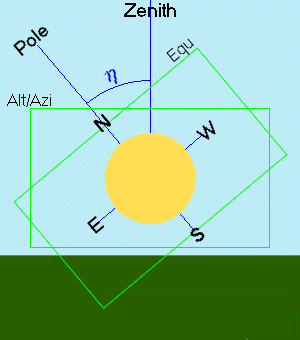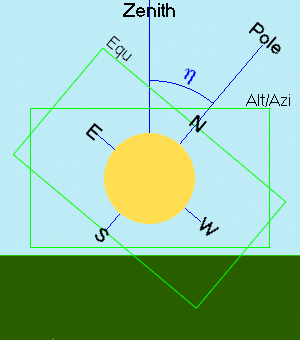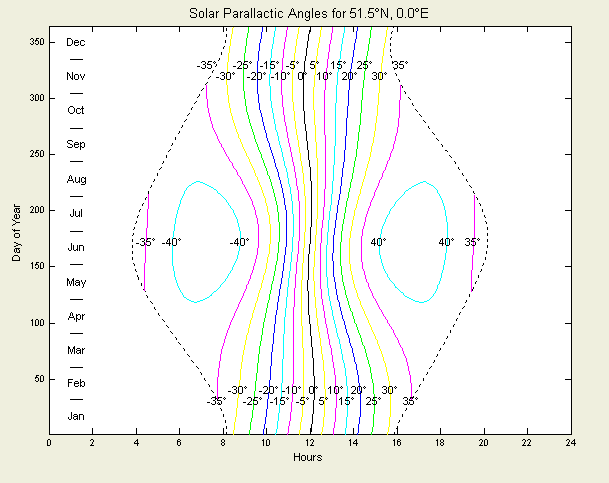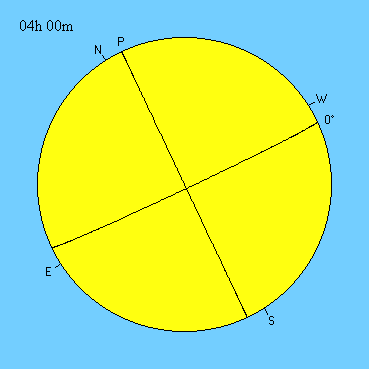|
Over recent years compact telescopes for solar observing have become more popular due to their small size and lightweight especially if fitted to altazimuth mounting. They are easily moved to various part of a garden to take advantage of available sunlight and can be easily transported to view events such as solar eclipses. These compact telescopes are available for both white light observing (with a suitable full aperture filter) and for hydrogen alpha observing. One disadvantage of using an altazimuth telescope mounting is that the cardinal points of the Sun (north, east, south and west) are more difficult to determine than if an equatorial type of mounting were used. With a telescope on an equatorial mounting, the top and bottom points on the solar disk are on a great circle that passes through the celestial pole. This means that the north and south cardinal points are always at the top or bottom of the solar disk and the east and west cardinal point are to the left or right. The exact orientation depends on whether the solar image is mirrored and/or flipped. Using an altazimuth mounting the top and bottom points on the solar disk are on a great circle that passes through the zenith. Now the cardinal points of the solar disk slowly change from sunrise to sunset. Only when the Sun is on the meridian are the cardinal points coincident with the top, bottom, left and right points of the solar disk. The differences in orientation of the Sun for the two telescope mounting types is illustrated below when the Sun has just risen and is just about to set at the one of the equinoxes (i.e. when the Sun is on the celestial equator) for an observer at 51.5°N. For illustrative purposes, a rectangular field of view is shown for the two mounting types. The angle between these fields of view is the same angle as between the great circles that pass through the middle of the Sun and the celestial pole and the zenith. This angle is known as the parallactic angle (h) and is also shown below. Only when the Sun is on the meridian do the two fields of view coincide.
The parallactic angle can be calculated using one of the expressions given below: sin(h) = sin(A).cos(f)/cos(d) cos(h) = (sin(f) - sin(d ).cos(z))/(cos(d).sin(z)) cos(h) = (sin(f).sin(z) - cos(f).cos(z).cos(A))/cos(d) where f = observer latitude, d = declination of the Sun and z = zenith distance (altitude = 90 - z) and A is azimuth angle of the Sun. The range of the parallactic angle, h, values for an observer at London (51.5°N, 0.0°E) is shown below. The dotted lines show when the Sun is on the horizon (i.e. at the time of sunrise and sunset). The black solid curve for an angle of 0° is when the Sun is on the meridian (i.e. due south). The parallactic angle has a positive value if the Sun is to the west of the meridian and negative to the east. At this latitude the maximum and minimum values of h are -42.7° and 42.7° and which occur at the summer solstice. The diagram also shows that h changes fastest during mid-summer at the time when the Sun is on the meridian; for example 19° per hour at London. The largest parallactic angle also occurs in mid-summer but much earlier and much later in the day. During mid-winter the parallactic angle changes much slower when the Sun is on the meridian; for example 10° per hour for London.
To illustrate the change in orientation of the Sun with an altazimuth telescope mounting, the animation below shows the Sun from sunrise to sunset on the summer solstice for an observer at London. Note that the minimum and maximum values for h do not occur at sunrise or sunset.
The parallactic angle is calculated and displayed in the solar observing programs Helio and Helio Viewer.
Last updated on 25 April 2006. |
|||||||||




